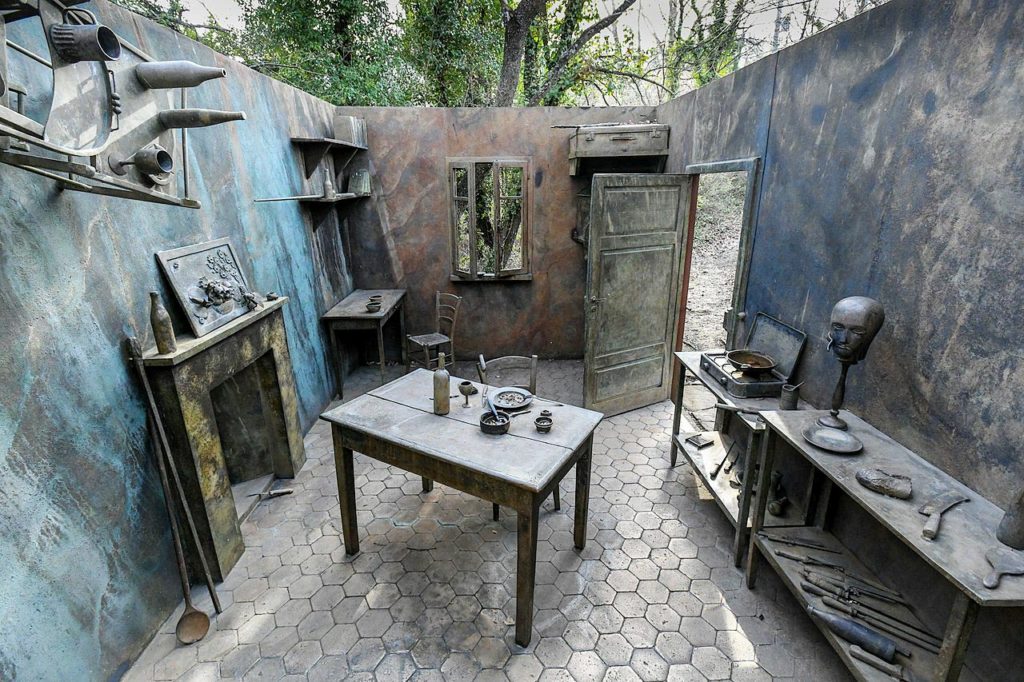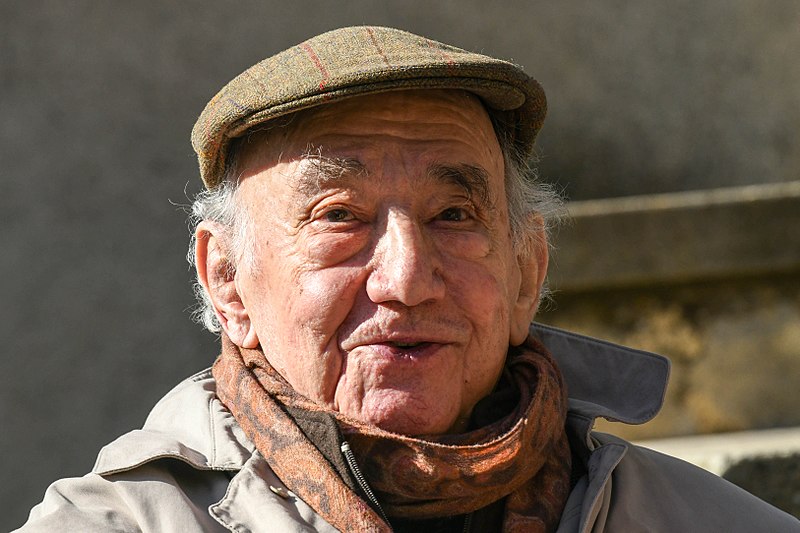Preface 2023
Preface – magazine 2023 A contemporary magazine feeds upon dynamism and vigour. It instantly perceives the inputs deriving from the readers and evolves, offering its best at...
Preface – magazine 2023 A contemporary magazine feeds upon dynamism and vigour. It instantly perceives the inputs deriving from the readers and evolves, offering its best at...
The garden of Daniel Spoerri, Founder EAT ART Old maps register it under the name of “Il Paradiso”. We are on the slopes of Monte Amiata, in front of the picturesque...
Since the dawn of time, man has tried to get in touch with the gods, perceived as superior intelligence, through the modified states of consciousness, both with the help of...
From Snow White’s cake to Homer Simpson’s donuts Delicacies have accompanied cartoons since their kick-off. It all began with a cake, the cake SnowWhite (1938) makes for the seven...
To talk about Florentine festivals, with particular reference to the Renaissance, means to look in-depth at the very fabric of the “City of the lily”, in all its sides...
Food surfaces in some “Mediterranean” detective stories, in different degrees, perfectly inserted in the narrative plot and not mere decorative accessory.«The...
Food has always had a place and a very distinct role in art, from the ancient world to today. Food is the protagonist in still life paintings and an important iconographic element...
Red coloured trousers, a white shirt, and a quick and easy-going walk anyone used to travel the world has, professor Charles Spence arrives at Syracuse University in Florence. We...
We cannot affirm that human’s taste has always been constant over the centuries and millennia. We remain astonished at how our tastes differ from our ancestors every time we read...
In ancient times, people prized saffron more for its medicinal qualities than for its culinary qualities. Egyptian papyrus already mentioned the orange-red stamens, which...
Our magazine moves around everything that represents the food culture. In this issue, we publish Alice Dini’s travel journal written along the Santiago way. It is a vivid...
Old maps register it under the name of “Il Paradiso”. We are on the slopes of Monte Amiata, in front of the picturesque village of Seggiano, a bundle of houses sitting on top of a hill in southern Tuscany. Here in this land, remote but full of charm and magnetic force, in 1997 the eclectic Swiss artist Daniel Spoerri, founder of EAT ART, created a Foundation and opened the garden that bears his name to the public. On the entrance gate is the Latin motto “Hic terminus haeret” (Here the borders join) to indicate an open space, without limits to art and thought.
Over 16 hectares of spontaneous vegetation, Spoerri has ‘bed out’ 150 works by more than fifty internationally renowned artists such as Eva Aeppli, J.R. Soto, Pavel Schmidt, Katharina Duwen, Alfonso Huppi. From his ironic “Grass Sofa” to his “Chambre No. 13 de l’Hôtel Carcassonne Paris” re-built and cast in bronze up to 160 geese in reinforced concrete and stone, which tumble freely along the slope of a hill. These are splendid creatures created by Oliver Estoppey, a Swiss sculptor and designer (born the canton of Vaud) with a dreamlike imagination. His monumental works coexist with minimal works, abstraction with figuration, dynamism with peace, playfulness with existential power.
The visit to the Garden – open from Easter to October – is an unforgettable multisensory experience also enlivened with a break at the “Non solo EAT ARTS” bistro. Here you can enjoy typical local dishes, such as handmade pasta with quality flours, very tasty main courses and excellent homemade desserts. It opens from Tuesday to Sunday from 10.30 to 18.00 – Friday and Saturday for dinner, upon reservation.

It is not easy to meet the artist in his “Paradise”, especially in the winter months. Nonetheless, we have managed to get in touch with him with the help of Susanne Neumann. She has been the cultural manager at the Garden since 2007. She is an elegant, refined and kind woman, with a versatile and multifaceted personality. She lives and works between Berlin (where she founded the Sleeping Dogs Gallery, in 2004), Vienna, Italy and Bavaria. She deals with videos, interactive photographic projects, painting, anthropology, and ‘mapping’. With her help, we managed to interview Daniel Spoerri.
You are the founder of Eat Art. What is your physical and metaphorical relationship with food and how was this artistic trend born? What did you want to convey with your ‘tableaux pièges’ (literally trap-pictures) created since the sixties of the last century and now exhibited in the most important collections in the world, such as the MOMA in New York and the Center Pompidou in Paris?
“When I created my first ‘tableau piège’, I still wasn’t thinking about Eat Art at all. I soon understood that food was the basis of human life and social life. Dinner around a table represents a real social event. It was somehow natural, therefore, that I become interested in recipes and preparing meals. I concentrated on the subject during my stay on the Greek island of Simi where I wrote a gastronomic diary. After nine months, I went to Germany and decided to open a restaurant in Düsseldorf. After that, I decided to set up the Eat Art Gallery”.
Let’s talk about your creature, the Garden. You have placed all the works, one by one, in a beautiful context, which is part of a breath-taking landscape habitat that opens as far as the eye can see in front of the picturesque village of Seggiano. What is the common thread that links the different installations and works in the exhibition path you have traced?
“I would say that there is no pre-established path. The numbering of the works is chronological, but those numbers represent my feeling, a personal and artistic approach to the territory.”
In your garden, you have created a sort of cenacle of artists you connect with through common experiences, stories spent together, affection, and admiration. You established a foundation in 1997: what is its main purpose?
“To deepen the interaction, the extraordinary dialogue that has always existed between art and nature”.
A tip, a suggestion for those who are about to visit your Garden. What is the most beautiful and dearest spot in this green valley, not surprisingly mentioned in the old maps with the toponym of “Paradiso”?
“I believe that each visitor can recognize and find his/her favourite spot. It also depends on the season, on the time of the day of the visit, on the singing of the birds but also on one’s mood. The garden is never the same. Some days, I prefer the intimacy of a refuge hidden in a small forest (“La Chambre n.13” or the “Courting couple”); others, the extraordinary view you can enjoy from the “Unicorns – Navel of the World” or from “The Graces””.

How do you see the future of this open-air museum and the works that are part of it? Can we speak of a spontaneous flow of things between life and death?
“Being outdoor installations, these works are naturally subjected to the inexorable transformation of time. It is clear that the management of the park with its 113 creations, more than 300 olive trees, its meadows and woods, becomes a demanding undertaking, considering also that we are a very small team”.
You started as a dancer and choreographer, before becoming one of the most accredited artists in the world of contemporary figurative arts. How important was it for your life and your artistic career to enjoy a good dose of irony?
“Irony – an attitude towards life – is a very serious matter”.
This is the final comment by Daniel Spoerri, a contemporary narrator who has questioned conformism, clichés and convictions with his poetics. A master who has transformed FOOD into a privileged interlocutor, a captivating and original link between art and life.
FIAMMA DOMESTICI
HIC TERMINUS HAERET
IL GIARDINO DI DANIEL SPOERRI
Strada Provinciale Pescina
Loc. Il Giardino
I – 58038 Seggiano GRinfo@danielspoerri.org
www.danielspoerri.org
+39 0564 950 553